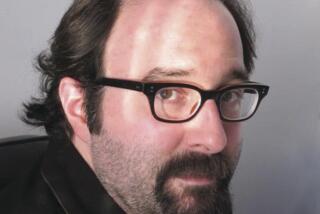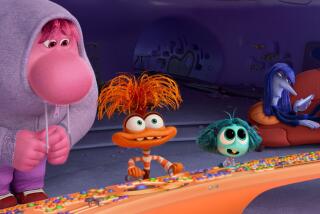MOVIE REVIEW : ‘Back to the Future’: Genial, Tidy Finale
- Share via
Time-travel scenarios almost always work in the movies, no matter how clumsily executed. In the case of the 1985 “Back to the Future,” no excuses were in order. The film was a highly inventive nonstop dither of time-warp confusion and, in Marty McFly’s rush to unite his parents-to-be, it even had a mite of “heart.”
“Back to the Future Part II” extended the storyline of its predecessor without adding much to its inventiveness. It wasn’t as bad as most people said it was at the time--it had pace and wit--but it didn’t really need to be made, either.
The third installment, “Back to the Future Part III” (citywide), was filmed on the heels of “Part II,” and it too has no particular reason for being (except, of course, to complete the series and cash in). It’s sprightly and inoffensive, though. And, for those who care, it satisfyingly ties up the various plot strands that were flapping in the breeze from the last installment. “Back to the Future” futurists will feel complete.
This time around, director Robert Zemeckis and screenwriter Robert Gale indulge their love of Westerns. (It’s that love that must have kept them interested in the project.) Through a series of blissfully nutty schemes, Marty McFly (Michael J. Fox) travels back to the Old West, circa 1885, to try and rescue Doc Brown (Christopher Lloyd) before he is shot in the back by Hill Valley’s chief lout, Buford (Mad Dog) Tannen (Thomas F. Wilson), an ancestor of Marty’s 20th-Century rival Biff Tannen.
Duded up in bargain-bin cowboy attire, calling himself “Clint Eastwood,” Marty reunites with Doc, who is posing as a blacksmith. (Doc said in Part II that he always wanted to live in the Old West.) Unlike the first two films, this new one, once it settles into the past, is essentially devoted to Doc. He’s smitten by an equally smitten schoolmarm (Mary Steenburgen) and the question arises: Will he be able to leave her and zip back to the future?
In its emphasis on Doc, “Part III” (rated PG) is a bit like an episode of some long-running TV show that gives over an entire segment to one of its character actors. There’s a pleasing humility in the way Fox hands the movie over to Lloyd. Or is it just that Fox has become tired of scampering around like some overage-underage hellion? Marty’s wind-up-toy athleticism has wound down, and that’s something of a relief. Fox has grown as an actor since he started this series, and it may be that, particularly after “Casualties of War,” he can’t quite find it in himself to careen about with the same cartoonish abandon.
Christopher Lloyd, on the other hand, appears to regard his role as a kind of actor’s redemption. With his great shock of white hair and his rubbery, permanently agape features, Doc still looks like a Kabuki mad scientist. But his love for Steenburgen’s Clara humanizes him; when he’s alone with her, or dancing with her, Doc is happily flummoxed by his own capacity for tenderness. He can’t quite get a fix on his romantic delirium, and he kind of likes the idea that he can’t explain his bliss. It’s a good joke: The mad scientist seeking to explain the unknowable comes face to face with the universe’s ultimate mystery: women.
Steenburgen is such an entrancing presence, with her own slightly out-of-time spaciness, that she keeps Clara’s scenes with Doc from becoming blubbery. She really is Doc’s soulmate; their mutual love of Jules Verne is their touchstone. It’s regrettable that Zemeckis doesn’t give over more of his movie to this couple’s lyrical clownishness. Marty may have cooled off but Zemeckis is still hot-footed; even though Part III is a more spacious and gentle entertainment than its predecessor, it doesn’t slow down for the emotional moments. It doesn’t quite give these balmy lovers their due.
Zemeckis may think he’s still working with the cartoon characters from “Roger Rabbit” and, in a sense, he is. But the cartoon inventiveness of his best work doesn’t have a chance to function in this Western setting. The filmmakers may love the idea of making a Western--even a mock-satirical one--but they don’t provide enough gags at the genre’s expense. They may be too awed by the form to make a satisfying joke out of it. (Parts of the film were shot in Monument Valley: John Ford country.)
Fox’s pint-size feistiness is used to comic advantage in a barroom brawl scene, and he gets to do a funny moon dance when Mad Dog shoots at his feet, but too much is made of the Clint Eastwood connection, and the overweening chumminess of it is a bit obnoxious. (Eastwood is given a “thank you” in the end credits.)
Besides, the Western is a dead genre for the mostly young audience that will see this film, so most of the in-jokes will be exclusionary--private jokes. (Kids who see the film aren’t likely to clamor for more Westerns.) Then again, the entire film (rated PG) is inlaid with in-jokes to the two previous films in the series. Is all this self-congratulation a matter of pride or a sign of creative exhaustion? A little of both, I think.
More to Read
Only good movies
Get the Indie Focus newsletter, Mark Olsen's weekly guide to the world of cinema.
You may occasionally receive promotional content from the Los Angeles Times.










